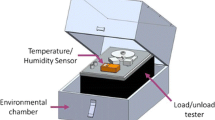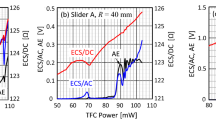Abstract
As a chemical modification of slider air bearing surface (ABS), fluorine ion implantation (FII) was conducted. FII treated ABS was fabricated to reduce slider surface energy, which is expected to reduce adhesion and friction force between the slider and disk. Tribological performance, such as slider flyability, was experimentally investigated. Touchdown speed, corresponds to a flying height of about 0.4 nm, was reduced by FII treatment. Slider touch-down and take-off hysteresis was also improved by reducing the adhesive force of the lubricant by fluorine-ion implantation. AE output and friction force were also reduced in the drag test. FII treated slider showed a 45% reduction of AE amplitude and 14% reduction of friction force. FII treatment was confirmed to be effective in improving slider flyability.











Similar content being viewed by others
References
Chiba H, Musashi T, Kasamatsu Y, Watanabe J, Watanabe T, Watanabe K (2005) Chemically modified air bearing surface for the near-contact regime. IEEE Trans Magn 41(10):3049–3051
Dai Q, Hendriks F, Marchon B (2004) Washboard effect at head–disk interface. IEEE Trans Magn 40(4):3159–3161
Dai Q, Knigge BE, Waltman RJ, Marchon B (2005) Time evolution of lubricant–slider dynamic interactions. IEEE Trans Magn 39(5):2459–2461
Homola AM (1991) The role of interfacial forces and lubrication in thin-film magnetic media. ASME Adv Inf Storage Syst 1:279–308
Lee S, Policarpou AA (2005) Microtribodynamics of pseudo-contacting head–disk interfaces intended for 1 Tbit/in2 IEEE Trans Magn 41(2):812–818
Mate CM, Dai Q, Payne RN, Knigge BE, Baumgart P (2005) Will the number add up for sub-7 nm magnetic spacings? future metrology issue for disk drive lubricants, overcoats, and topographies. IEEE Trans Magn 41(2):626–631
Ono K, Yamane M, Yamaura H (2005) Experimental and analytical study of bouncing vibrations of a flying head slider in a near-contact regime. ASME J Tribology 127:376–386
Tagawa N, Mori A (2005) Effect of cyclotriphoshazene-terminated PFPE lubricant film on slider touch-down and take-off characteristics in hard disk drives. In: ASME information storage and processing systems conference, Santa Clara
Tani H, Goshi K, Suzuki K, Hamaguchi T (2006) Contact hysteresis behavior of textured pad slider in head-disk-interface. IEEE international magnetic conference, San Diego, California, p 643
Wood R (2000) The feasibility of magnetic recording at 1 terabit per square inch. IEEE Trans Magn 36:36–42
Xu J, Kohira H, Saegusa S (2002) Contact ABS design concepts. In: Proceedings of the 2002 ASME/STLE joint international tribology conference, Cancun, Mexico, pp 33–38
Xu J, Kohira H, Tanaka H, Saegusa S (2005) Partial-contact head–disk interface approach for high-density recording. IEEE Trans Magn 41(10):3031–3033
Xu J, Tokisue H (2002) Contact vibration of micro-textured sliders. ASME J Tribology 124:281–287
Author information
Authors and Affiliations
Corresponding author
Rights and permissions
About this article
Cite this article
Shimizu, Y., Xu, J., Saegusa, S. et al. Air-bearing surface chemical modification for low-friction head–disk interface. Microsyst Technol 13, 811–816 (2007). https://doi.org/10.1007/s00542-006-0282-0
Received:
Accepted:
Published:
Issue Date:
DOI: https://doi.org/10.1007/s00542-006-0282-0




